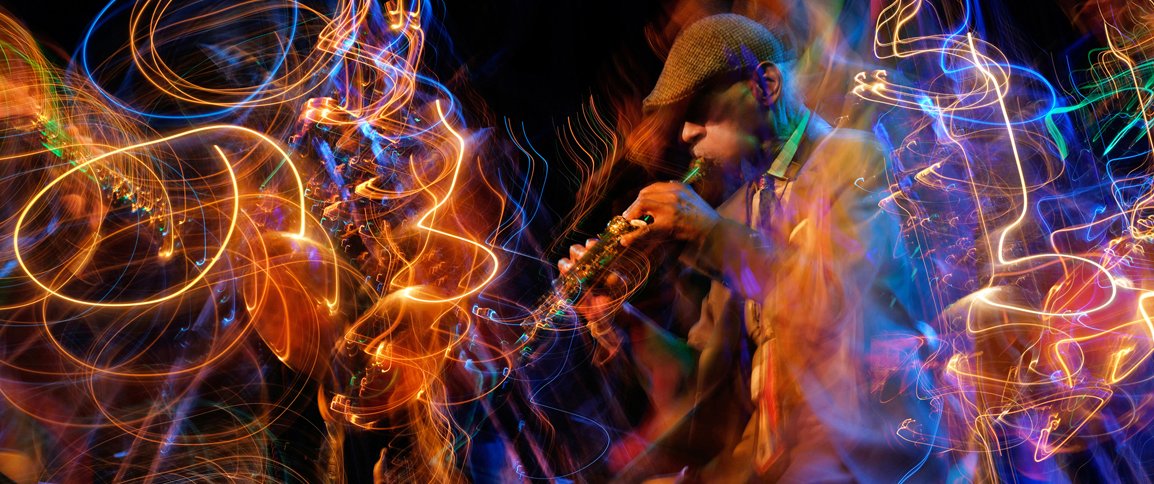“Tangible Sound” Strives to Amplify Music through Multiple Media Modes
Two-day exhibit at Asian Improv aRts Midwest features creative musicians on screen and in the moment
Before today’s session begins, tune up, please, by viewing the first photograph above that shows Roscoe Mitchell in thought/action. Can you hear him? What might the lines feel like if you could touch them? Do the lights and swirls trigger hunger?
This moment – captured by photographer and former Jazz Institute of Chicago Executive Director Lauren Deutsch, and then enhanced via computer by filmmaker/music producer Jonathan Woods – is included in “Tangible Sound: A Visual Celebration of Creative Improvised Music.” Presented on May 9 and 10 by Asian Improv aRts Midwest, 4875 North Elston, this exhibit featured 80-plus photographs reimagined through animation documenting musicians in their most intense, intimate moments. While Tatsu Aoki and Edward Wilkerson Jr. provided a live, improvised soundtrack – the former on bass and shamisen, the latter on tenor saxophone and various reed instruments – these images were displayed on one, 80-foot-wide, 10-foot-long hexagonal screen.
“Tangible Sound,” Deutsch said during a recent conversation, is what she has named her photography business, website, self-published books, and previous exhibits. These words also explain how she attempts to embrace improvised music through photography.
“I feel like the work really does make sound, something that is ethereal, tangible almost, like something you could touch,” she said. “The idea that you could hear music, that you could experience music in a different way, was what I was trying to convey with the title.
“The subtitle came afterwards,” Deutsch continued. “How Jonathan and I conceived of putting this show together is that we were essentially creating mini-concerts or sets of a concert.”
For six months, Deutsch and Woods collaborated exclusively through their computers. “Because of internet complications, I couldn’t see him,” she said. “But I could see the work he was doing as he was pressing notes and turning knobs.” Deutsch and Woods viewed numerous photographs together, attempted various approaches, “and then decided together what felt right, whether that was effects, timing, rhythms or transitions,” Deutsch added. Woods then employed a software program called Resolume and a MIDI keyboard to complete the reimagination.
Resolume’s nature, Woods explained during the same conversation, “gives you lots of spontaneous control over when images appear on the screen. It’s also designed to give you the ability to shift, change, and morph different visual parameters.”
When discussing the Roscoe Mitchell photograph, Deutsch noted that she moved her camera to make the swirls appear. These swirls represented light hitting his saxophone. “There was lots of movement in the picture that seemed like it abstracted the music that he was playing,” she said.
When adding his observations about this photograph, Woods discussed its original appearance. First, imagine this: A blue rectangle with four orange swirls at the bottom.
“The swirls actually have a shape that looks very much like a raindrop, because of the way Lauren photographed Roscoe,” he explained. “When we used Resolume, we transformed it into a square that rotated in a very slow fashion. On occasion, we would be able to, in an instant, make it move or quiver a little bit, and then go back to something very smooth and slow.”
The original photograph spoke to one level of experience, Woods added, “but the (enhancement) speaks to a whole other level. And Lauren was like, ‘This is what I’m looking for.’”
While interpreting music into visual art, Deutsch and Woods began seeing themselves as composer and conductor, respectively. Deutsch would suggest an order for the photographs to be enhanced, and Woods would call these directions an arrangement.
“This made me happy, because that made it feel like it was one piece of cloth,” she said. “We had an ensemble comprised of all these musicians whose music we were representing. That served us well and really made the project flow.
“These photographs are not about me. They are about the music and the musicians,” Deutsch continued. “I have always felt, in a sense, that I was collaborating with them. I’m trying to capture the feeling of the music.”
As conductor, Woods maintained an acute vigilance about the images’ rhythm and timing. He aimed to interpret everything with sensitivity, making sure that his output would avoid becoming overwhelming or muted through too much nuance.
“We were able to honor the source material, the music, and to explore additional possibilities of how it could be received,” he said.
Woods’ contributions were also influenced by his synesthesia, which happens when one sense evokes another that is, seemingly, unrelated.
“There are times when I hear music, and I will see shapes and/or designs and colors,” he said. “Also, I will see imagery and hear all kinds of things. That helped in this experience.”
Say What? Say: What!
Every “Tangible Sound” segment began with a quote Deutsch had found in various publications. “Quotees” included cellist Tomeka Reid, Aoki, and Mitchell.
Said Reid, whose quartet will perform at this year’s Chicago Jazz Festival: “This music teaches you to find comfort in discomfort, so you're ready for whatever comes your way.”
Said Aoki, Asian Improv aRts Midwest’s founder: “Who we are is what we sound like, and what we sound like is who we are.”
Mitchell’s quote, “It’s in outer space. Who knows what you’re going to see there. Everything’s different,” most intrigued the exhibit’s creators. “It felt like a mission statement for everything that followed,” Woods said. “It stayed in our heads so strongly.”
RE: Actions!
Deutsch estimated that more than 100 people attended the two-day exhibit. While pleased with such support, the feedback from some attendees surprised her.
“Lots of people said, ‘Man, I haven’t felt this way since the last time I did mushrooms or LSD. The immersive experience clearly resonated with people who had had psychedelic experiences, which I have not had, I have to say,” she said, as her breathing and rapid eye movement escalated briefly into double time.
Experiencing “Tangible Sound,” Woods added, proved how experiencing art can dissolve inhibitions that prevent people from enjoying life.
“It’s wonderful that we have that here,” he said. “In a city that prides itself so strongly on these traditions, we have so many people show up and have that sense of awe about the beauty we have on Chicago’s music scene.”
“I’m glad we were able to create something that resonated with people,” Deutsch added, “and that people wanted it, received it, and were transformed by it.”






